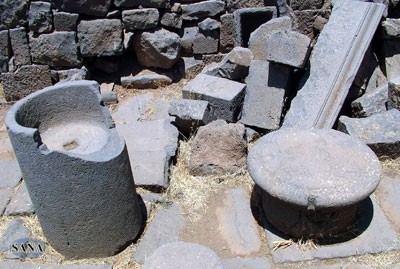Excavations in Sweida resulted in important new discoveries, the most important is the lower left part of the ancient western archaeological gate of Sweida city dating back to the end of the first century AD. It is a rectangular basaltic rocks, carved well and relatively large in size.
Head of Sweida Antiquities Bureau, Hussein Zeineddin, said that this part is located north of the road leading to al- Najmeh(star) Palace down more than two meters from its level and has a height of 2.45 meters, a length of 2.5 meters and a width of 2.5 meters. The work will continue to uncover the right lower part of the gate where the upper portions of it appeared broken (by man).
“The excavation works at the site of Breakah Hill in Sweida, date back mainly to the Middle Bronze 2000/1500 BC, also resulted in detecting ruins of a residential house back to the Aramaic period “700 BC”. The house was built of basalt stone in addition to a group of earthen wine jugs, pottery jars belonging to the same period,” Zeineddin said.
“These discoveries are added to the ones that have been found in the processes of previous excavations which included two rooms, one of them included nine earthen wine jugs of large size that were arranged in three rows and were used to save wine in addition to a floor paved with small stones, and a foundation of two rooms, one of them contained a pottery basin and the second contained a large jar,” Zeineddin stressed.
“Several stone tools and broken bones, pottery vessels and a mold for pouring gold ornaments that included elaborate inscriptions and decorations made also have been discovered,” Zeineddin added.
“The other room contained artifacts made of colored pebbles taken from river in addition to a stone basin to crush the dyes, small silky basaltic stone for waxing threads, a chamber to save the earthen wine jugs, as well as a piece of unique ivory a tube shaped with diameter of about “5 cm”. This evidence reflects a boom in the ivory industry in the Aramean period during the first three centuries of the first thousand BC,” head of the Antiquities Bureau clarified.
” Some of excavation missions operating at Breakah Hill site also discovered architectural ruins date back to the eighteenth century BC. Beside the site, there were graveyards in the form of pottery jars and a number of oil pitchers that were used for transporting olive oil and other sorts of oils to different parts of Bilad As Sham, and Egypt. Among the finds, there was a “beetle” shaped seal that belonged to an Egyptian traders. They left this legacy at this site near a spring of water,” he pointed out.
“The National Excavation Mission also found, in the area of temples at the archaeological site of Sea,i specifically in the eastern courtyard of Ze al Sharat Temple, located between the temples of Baal Shamin in the West and the Great Temple in the east, the Haram wall of this temple on the southern- eastern side and found a “corridor” paved with basalt tones leads from the end of the eastern Haram area and west of the Nabatiyeh gate to the area of south the southern Chapel in addition to a number of pottery saddles and coins belonging to the two Nabatiyeh and Romanian eras, noting that work will continue at the two archaeological sites of Breakah Hill and Sea,i in the future due to their historic significance,” Zeineddin concluded.
Sh. Kh.

